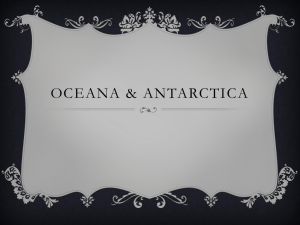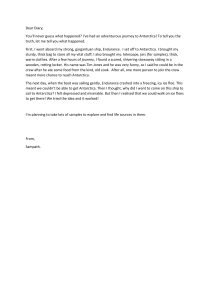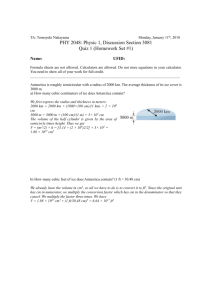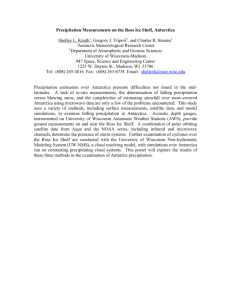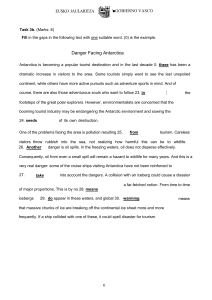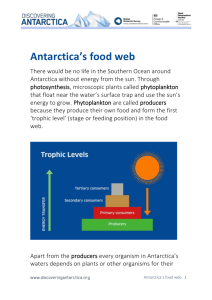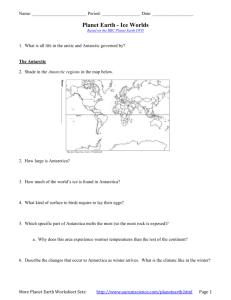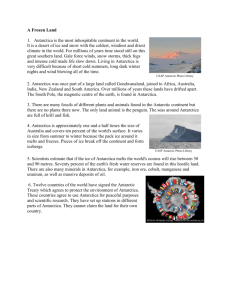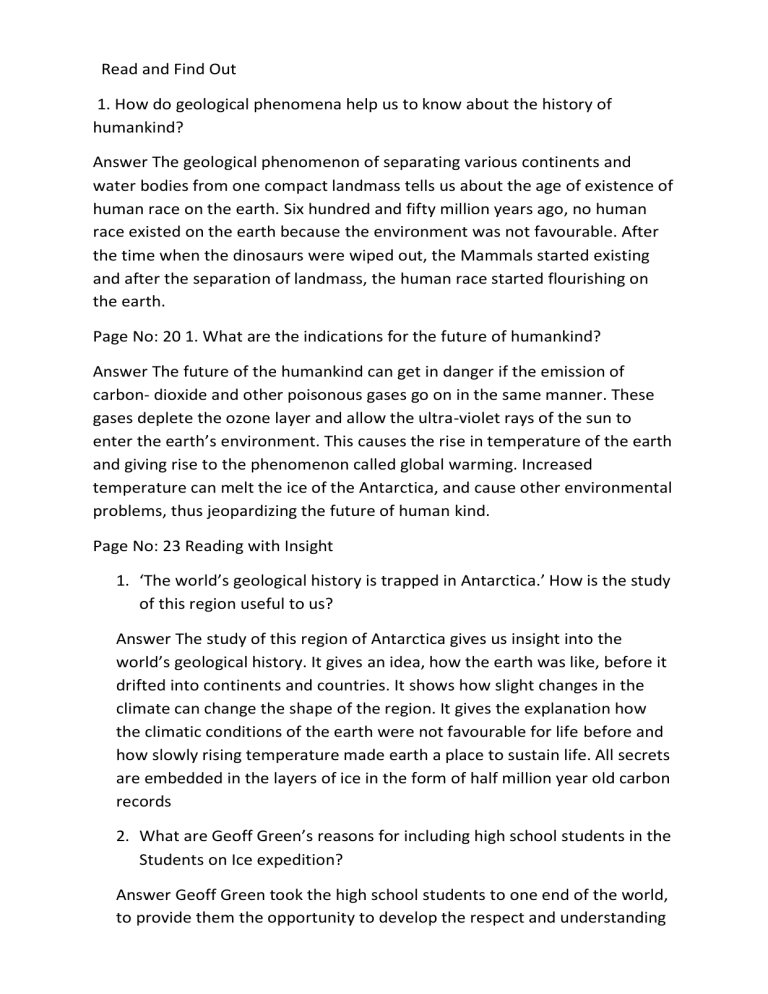
Read and Find Out 1. How do geological phenomena help us to know about the history of humankind? Answer The geological phenomenon of separating various continents and water bodies from one compact landmass tells us about the age of existence of human race on the earth. Six hundred and fifty million years ago, no human race existed on the earth because the environment was not favourable. After the time when the dinosaurs were wiped out, the Mammals started existing and after the separation of landmass, the human race started flourishing on the earth. Page No: 20 1. What are the indications for the future of humankind? Answer The future of the humankind can get in danger if the emission of carbon- dioxide and other poisonous gases go on in the same manner. These gases deplete the ozone layer and allow the ultra-violet rays of the sun to enter the earth’s environment. This causes the rise in temperature of the earth and giving rise to the phenomenon called global warming. Increased temperature can melt the ice of the Antarctica, and cause other environmental problems, thus jeopardizing the future of human kind. Page No: 23 Reading with Insight 1. ‘The world’s geological history is trapped in Antarctica.’ How is the study of this region useful to us? Answer The study of this region of Antarctica gives us insight into the world’s geological history. It gives an idea, how the earth was like, before it drifted into continents and countries. It shows how slight changes in the climate can change the shape of the region. It gives the explanation how the climatic conditions of the earth were not favourable for life before and how slowly rising temperature made earth a place to sustain life. All secrets are embedded in the layers of ice in the form of half million year old carbon records 2. What are Geoff Green’s reasons for including high school students in the Students on Ice expedition? Answer Geoff Green took the high school students to one end of the world, to provide them the opportunity to develop the respect and understanding for the earth. He wanted to make the future policy-makers to experience how difficult it would have been for the earth to sustain life by rising its temperature. He wanted them to understand that any interference in nature can cause drastic mishappenings in the future when the students see the ice shelves melting and collapsing, they can estimate the kind of environmental troubles ahead in their future. 3. ‘Take care of the small things and the big things will take care of themselves.’ What is the relevance of this statement in the context of the Antarctic environment? Answer This statement has great relevance in the context of the Antarctic environment. A small change in the environment can give rise to drastic developments. Antarctica has a small biodiversity. The example of small grass called phytoplankton can be studied in this context. These microscopic grasses undergo the process of photosynthesis and serve as food for number of marine birds and animals. The author says if there is further depletion of the ozone layer, it will affect the phytoplanktons and the carbon cycle on the globe. This whole process can jeopardize the existence of all the marine birds and animals. So if we take care that processes carried over by these small grasses are carried out properly, the bigger animals and birds will fall into the place on their own. 4. Why is Antarctica the place to go to, to understand the earth’s present, past and future? Answer Antarctica gives us an idea, how the earth would have been like millions of years ago and how it got divided into various earth masses. The melting and colliding ice masses also give us an insight into how our future is going to be, if we continue with interference in the working of the nature. Moreover, Antarctica holds into the depths of its ice half-million year old carbon records, which are helpful in understanding the past, present and future of the earth. Therefore, Antarctica is the place which reveals our past, shows our present and visualizes our future Journey to the end of the Earth Before you read If you want to know more about the planet’s past, present and future, the Antarctica is the place to go to. Bon Voyage! EARLY this year, I found myself aboard a Russian research vessel — the Akademik Shokalskiy — heading towards the coldest, driest, windiest continent in the world: Antarctica. My journey began 13.09 degrees north of the Equator in Madras, and involved crossing nine time zones, six checkpoints, three bodies of water, and at least as many ecospheres. Journey to The End of The Earth By the time I actually set foot on the Antarctic continent I had been travelling over 100 hours in combination of a car, an aeroplane and a ship; so, my first emotion on facing Antarctica’s expansive white landscape and uninterrupted blue horizon was relief, followed up with an immediate and profound wonder. Wonder at its immensity, its isolation, but mainly at how there could ever have been a time when India and Antarctica were part of the same landmass. Part of history Six hundred and fifty million years ago, a giant amalgamated southern supercontinent — Gondwana — did indeed exist, centred roughly around the present-day Journey to the end of the Earth 19 Antarctica. Things were quite different then: humans hadn’t arrived on the global scene, and the climate was much warmer, hosting a huge variety of flora and fauna. For 500 million years Gondwana thrived, but around the time when the dinosaurs were wiped out and the age of the mammals got under way, the landmass was forced to separate into countries, shaping the globe much as we know it today. To visit Antarctica now is to be a part of that history; to get a grasp of where we’ve come from and where we could possibly be heading. It’s to understand the significance of Cordilleran folds and pre-Cambrian granite shields; ozone and carbon; evolution and extinction. When you think about all that can happen in a million years, it can get pretty mind-boggling. Imagine: India pushing northwards, jamming against Asia to buckle its crust and form the Himalayas; South America drifting off to join. North America, opening up the Drake Passage to create a cold circumpolar current, keeping Antarctica frigid, desolate, and at the bottom of the world. For a sun-worshipping South Indian like myself, two weeks in a place where 90 per cent of the Earth’s total ice volumes are stored is a chilling prospect (not just for circulatory and metabolic functions, but also for the imagination). It’s like walking into a giant ping-pong ball How do geological phenomena help us to know about the history of humankind? devoid of any human markers — no trees, billboards, buildings. You lose all earthly sense of perspective and time here. The visual scale ranges from the microscopic to the mighty: midges and mites to blue whales and icebergs as big as countries (the largest recorded was the size of Belgium). Days go on and on and on in surreal 24-hour austral summer light, and a ubiquitous silence, interrupted only by the occasional avalanche or calving ice sheet, consecrates the place. It’s an immersion that will force you to place yourself in the context of the earth’s geological history. And for humans, the prognosis isn’t good. • 1. 2. 3. • 1. 2. 3. 4. 5. • 1. 2. 3. 4. 5. JOURNEY TO THE END OF THE EARTH Points to Remember Summary The writer visited Antarctica, the coldest, driest and windiest continent in the world, aboard the Russian research vessel, Akademik Shokalskiy. The journey, beginning at Chennai, passed through many areas, geographical, legal, ecological and temporal. The writer’s first reaction to the continent was of relief, followed by wonder at its vastness, seclusion and geological history. Part of History Before human evolution, Antarctica was part of a huge tropical landmass called the Gondwana land, which flourished 500 million years ago. Biological (flora and fauna), geological (changing continents) and geographical (climatic)changes occurred and Antarctica separated and moved away evolving into what it is today. A visit to Antarctica gave the writer a deeper understanding of fold mountains, the earth’s history, ecology and environment. The writer felt unsettled in two weeks time not only because she came from a much hotter place, but also because all features of human civilization were absent from an already desolate landscape. The long summers, the silence broken occasionally by cracking ice sheets and avalanches, the blue whales and ice bergs, all contribute to an ecological implication that the future for humans isn’t good. Human Impact Humans, who are known to have existed for a mere 12000 years, have caused tremendous impact and played havoc with nature. Population explosion, putting a strain on available resources, carbon emissions, fossil fuels and global warming have all resulted in climatic and ecological imbalances that have also affected Antarctica. Antarctica, though unpopulated, has been affected and there are concerns for its half a million year old carbon records trapped under its ice sheets. The ‘Students on Ice’ programme, an initiative of Canadian adventure educator, Geoff Green takes students on expeditions to Antarctica, to create awareness in them, the future policy makers. The stark proof of global warming and environmental threats helps students attain an understanding of ecosystems and biodiversity of our planet. 6. An amazing display of the food chain of the Southern Ocean helps in the understanding that further depletion of the ozone layer, will set off a chain reaction that will affect the global carbon cycle. 7. The simple truth is, take care of the small things and the bigger ones will automatically be taken care of. • Walk on The Ocean 1. Before their return, the writer got an opportunity to walk on the ocean at 65.55 degrees south, which made her realize that she was walking on 180 meters of ocean water, a rich kaleidoscope of life. 2. Reaching home, she wondered whether Antarctica would ever be warm again, how much difference a million years can make and, that each day makes a difference. Q1.How does the geological phenomenon help us to know about the history of mankind ? Ans: Geological phenomena give one an insight into why and how the present landforms came into being. About six hundred and fifty million years ago , there existed a giant southern supercontinent Gondwana. It thrived for 500 million years and finally it broke into separate countries as they exist today. By visiting Antarctica we can know from where we have come from and where we are heading .It also helps us understand the importance of Cordilleran folds and pre-Cambrian Granite shields ,ozone and carbon and also about the evolution and extinction. . Its ice cores hold more than half –million-year old carbon records which are useful for the study of past. Q2 .What are the indication for the future of mankind ? • Future of mankind appears dismal. • Increase in population has led to a “population boom.” • Greatly depleted our resources of nature that destroyed forests and extinction of certain species of wildlife. • Excessive burning of fossil fuels has created a blanket of carbon dioxide around the earth. • Antarctic environment has been affected by global warming- this is clear from receding glaciers and collapsing ice shelves. • These grave indications do not anger will for the future of mankind NCERT QUESTIONS (understanding the text) Q1 How is the study of this region useful to us? • Antarctica – only place in the world remaining pristine (never sustained human population) • holds in its ice-cores half million year-old carbon records • only place to study Earth’s past, present and future • gives an insight into how the earth forms and continents as they are today came into being tells us about repercussions of environmental changes (phytoplanktons) can enable us to • study problems of global warming (glacier retreating, ice-shelves collapsing) • concept of evolution and extinction • significance of Cordilleran folds and granite shields; ozone and carbon Q.2. What are Geoff Green’s reasons for including high school students on Ice Expedition? • Ans: A visit to Antarctica makes it quite clear and there one can see the ice shelves melting. ‘Students on Ice’ is aprogramme headed by Canadian Geoff Green. He aims at organizing this programme by taking high school students to the ends of the world. He thinks it most essential to provide the students with inspiring educational opportunities to know more about the Antarctica. Through this they will generate a new understanding and respect for our planet. Earlier Geoff Green had organized programme with celebrities and rich people which gave him back only in a limited way. Since the students are young minds and full of adventurous activities they can learn, act and absorb much by visiting the Antarctica. They can see through their own eyes glaciers retreating and ice-shelves collapsing. They can realize the future dangers, catastrophic effect of climatic changes and the global warming. The Antarctica provides the young students a perfect place to study the varied changes occurring in the environment. These little changes can have significant consequences. The students can see those grasses of the sea that flourish, nourish and sustain the entire Southern Ocean’s food chain. Thus theprogramme provides a lively study of changes and the realities going on the Antarctica. Q3. ‘Take care of small things and big things will take care of themselves.’ What is the relevance of this statement in the context of the Antarctica’s Environment ? Ans : Antarctica has a simple ecosystem and lacks biodiversity ,it is the best place to study how little changes in the environment can have big consequences. The author gives the example of very small single celled plants called phytoplankton which nourish and sustain the entire southern ocean‘s food chain. The phytoplankton uses the energy to absorb carbon and also synthesize various organic compounds through photosynthesis. Scientists have forewarned that if Ozone layer depletes any further it will have a direct impact on the activities of the phytoplankton this will lead to a chain reaction adversely affecting the lives of marine animals and birds of the region which will further result in the disturbance global carbon cycle . So, it is expected of man to pay special attention to tiny forms of animal and plant life and prevent the depletion ofozone layer by reducing carbon dioxide emissions.If we take care of small things big things will automatically fall into place • Q4. Why is Antarctica a place to go to ,to understand Earth’s present ,past and future? Ans. Antarctica is a place to go to ,to understand Earth’s present ,past and future. Six hundred and fifty million years ago , the present day Antarctica was surrounded by a giant amalgamated Southern supercontinent called Gondwana. Thus Antarctica belongs to ancient geological era when human beings had not yet evolved ,the climate was warm in the continent and supported a huge variety of flora and fauna. Later ,the dinosaurs were wiped out and mammals began to evolve . At this juncture Gondwana got separated into countries.So to visit Antarctica is now to be a part of that history.It is to understand the significance of Cordilleran folds and pre-Cambrian granite shields; ozone and carbon; evolution and extinction. (past) Since the planet is unravaged by human population and civilization ,it remains relatively pristine. Its ice cores hold more than half –million-year old carbon records which are useful for the study of past ,present and future of our planet. We can realize the threat of global warming by seeing glaciars melting and ice shelves collapsing. (present) Antarctica is the best place to study how little changes in the environment can have big repercussions. Phytoplanktons nourish and sustain the entire Southern Ocean’s food chain. Further depletion in the ozone layer would affect the lives of all the marine animals and birds of the region and the global carbon cycle. It could also lead to the end of the world. In this way it suggests future possibilities about our planet. (future) ADDITIONAL QUESTIONS SHORT QUESTIONS Q1.What was the Akademik Shokalsky? Where was it headed and why? 1. (Akademik Shokalsky was a Russian Research vessel.It was heading towards the coldest, driest windiest continent in the World ,Antarctica They were heading to be part of ‘Students on ice Programme’) Q2.How does the author describe the Antarctica? Q3.How did the Antartica amaze the writer when he first saw it? ( relief followed by immediate and profound wonder at Antarctica’s immensity and isolation) Q4 How is present day Antarctica different from GONDWANA? (p 19 ,1st para) Q5 Why does Tishani Doshi call her two week stay in Antarctica ‘a chilling prospect’? (For the author who was accustomed to live in a warm climate ,staying for 2 weeks in a place where 90% of earth’s total volume are stored is a chilling prospect. Coldness of the region not only restrains her circulatory and metabolicfunctions but also her imagination. Q6.Why does one lose all earthly perspective on reaching Antarctica? (-its like walking into a giant ping pong ball -devoid of any human markers-no trees , billboards and buildings -visual scale ranges from microscopic to macroscopic) Q7 What sort of brightness and silence prevail in Antarctica during summer?(p20 ,1st para) Q8."And for humans, the prognosis is not good". Explain the situation & observation. (The span of 12000 years of human existence is quite insignificant in comparison to earth's history-but man has created ruckus- by concretizing to nature, burning fossil fuels-that ascertain & bleak future) Q9 How long have the human civilizations been around? How has it affected the earth and its resources? (p-20 ,2ndpara) Q7.How is Antarctica a crucial element in the debate on climate change? (Because it has no population, but more importantly its holds in its ice-cores half million-year old Carbon record) Q8 What was the objective of the ‘Student on Ice Programme’ ? (p-21 ,1st para) Q9 What are the reasons behind the programme’s success? (p-21 ,2nd para) Q10 How does Antarctica differ from the earth? (Antarctica-has never supported human existance-24 hrs austral light makes one lose entire earthly sense-the visual scale ranges from microscopic to the mighty-a different phenomenon-no trees, no bill boards , no buildings) Q11 What experience did the author have near the Antarctica circle? Q.12 What is Gondwana? Six-fifty million years ago, a super continent existed present day Antarctica called Gondwana. Gondwana thrived for 500 million years. As mammals replace the dinosaurs the landmass separated into countries. LONG QUESTIONS Q1 Describe the author’s journey to the end of the Earth ? Ans The Author was part of the ‘Student on Ice programme’ which made her head to Antarctica .To go there she boarded the Russian research vessel – Akademik Shokalsky and headed towards Antarctica .Crossed nine time zones,six checkpoints, three water bodies and many ecospheres . • • She was with a group of teenagers on ‘Student on Ice ‘ programme, whose aim was to develop new understanding and respect for the planet They closely saw glaciers retreating and ice shelves collapsing and began to realize that the threat of global warming was very real. Most enjoyable experience of the author was walking on the ocean with a metre-thick ice underneath and 180 metres of living,breathing salt water below the ice Q2 Describe the impact of Antarctica on the writer. It was an amazing, alluring and mind boggling experience. Amazed to see the wide stretch of sea under the blue horizon. It was a place which has the history of mankind embedded deep into the layers of the ice. • • The sight of collapsing ice shields, breaking of ice-bergs and melting of ice was an eye opener. It made the author and his team aware of the dangers the future times are having in their folds. Q3 What are phytoplanktons? How are they important to our ecosystem? Q4. What is the significance of the title` Journey to the End of the Earth’. The title, ‘Journey to the End of the Earth,’ has more than one meaning. It describes an educational journey to Antarctica undertaken by groups of high school students to learn more about the real impact of Global Warming and the future of the earth. 52 students went to the coldest, driest, windiest continent in the world called Antartica in a Russian research vessel, the Akademik Shokalskiy. The author calls it a journey to the end of the earth because it began 13.09 deg North of Equator in Madras, involved crossing nine time zones, six checkpoints, three oceans and three ecospheres. She travelled over 100 hours in combination of a car, an aeroplane and a ship. The journey, being to the extreme south of the earth, is really towards the end of it. Another meaning of this title is more significant as the warnings that Antarctica gives are shocking and much concerning the humanity and the millions of other species on the earth. The changes taking place in Antarctica are pointing a warning finger at the existence of the earth; the earth is journeying to its end! Q5 “A lot can happen in a million years but what a difference a day makes”. Discuss with reference to the lesson. Q6. By whom and with what objective was the “Students on Ice” Programme started? How far has it achieved its goals?
